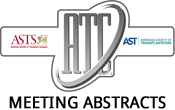2022 American Transplant Congress
Novel Role of CD74 in Regulatory T Cell Homeostasis and Function in Allo-Immune Response
1Brigham and Women's Hospital, Boston, MA, 2Yale University School of Medicine, New Haven, CT
*Purpose: Identifying new molecular targets based on our understanding of the biology of the allo-immune response in the allograft microenvironment is critical to develop more…2022 American Transplant Congress
Analysis of Induction Dose and Incidence of CMV Viremia in High Risk (HR; D+/R-) Renal Transplant Recipients
University of Pittsburgh Medical Center, Pittsburgh, PA
*Purpose: Depleting induction puts patients at risk of opportunistic infections. Our protocol aims for 5-6mg/kg cumulative dose of antithymocyte globulin(ATG) divided over 4 doses. It…2022 American Transplant Congress
Single Cell And Spatial Transcriptomics Of Blood And Biopsies Reveals Enhanced Alloantigen Presenting Function And T-follicular Helper Cell (tfh) Expansion Early After Pediatric Liver Transplantation
*Purpose: We have previously reported enhanced B-cell presentation of donor antigen during early T-cell mediated liver transplant (LT) rejection.*Methods: To characterize B-cell related immunological mechanisms…2022 American Transplant Congress
A Signature of Tolerance Which Identifies Subclinical Rejection-Free Patients at One Year After Kidney Transplantation
*Purpose: Spontaneous and rare cases of patients undergoing a functional renal transplant in the absence of immunosuppression represent a particular situation of immune tolerance. We…2022 American Transplant Congress
Utilizing Microporous Annealed Particle (MAP) Gel as an Immunomodulatory Carrier for Islet Delivery
*Purpose: To investigate if coating with MAP gel improves dissociated or whole islet transplantation outcome.*Background: MAP gel platform technology is composed of hydrogel microspheres that…2022 American Transplant Congress
Early Outcomes of Single Dose Eculizumab for Abo-Incompatible Living Donor Renal Transplantation
*Purpose: Use of ABO-incompatible (ABOi) donors increases access to living donor renal transplantation (LDRT). Conventional desensitization with plasmapheresis (PLEX) allows safe ABOi transplantation when pre-transplant…2022 American Transplant Congress
Association of Pre-Transplant Anti A1 IgM Antibody Titers with Survival Outcomes in A2/A2B to B Kidney Transplantation
Vanderbilt University Medical Center, Nashville, TN
*Purpose: The new kidney allocation system implemented in 2014 has allowed blood type B recipients to receive kidneys from A2/A2B donors. Although many centers use…2022 American Transplant Congress
Evaluating Long Term Outcomes in Kidney Transplant Patients with TruGraf Gene Expression and TRAC Dd-cfdna in the TRULO Study
Eurofins Transplant Genomics, Framingham, MA
*Purpose: The aim of this study is to evaluate long term clinical outcomes in kidney transplant patients undergoing non-invasive rejection monitoring with the OmniGraf® biomarker…2022 American Transplant Congress
Recipient Treatment with Anti-CD122 mAb Prolongs Kidney Allograft Survival During Antibody-Mediated Rejection without Impacting NK Cell Activation within the Graft
Cleveland Clinic, Cleveland, OH
*Purpose: Dysregulated donor-specific antibody (DSA) responses are induced in B6.CCR5-/- mice transplanted with complete MHC mismatched kidney allografts and are required for rejection of the…2022 American Transplant Congress
Long-Term (>1 Year) Rejection Free Graft Survival of Kidney Xenografts with Triple Xenoantigen Knockout and Multiple Human Transgenes in Cynomolgus Monkeys
*Purpose: Pigs with deletion of 3 carbohydrate xenoantigens (triple knock-out, TKO) are expected to be optimal donors for human xenotransplantation. We have previously shown that…
- « Previous Page
- 1
- …
- 8
- 9
- 10
- 11
- 12
- …
- 172
- Next Page »
